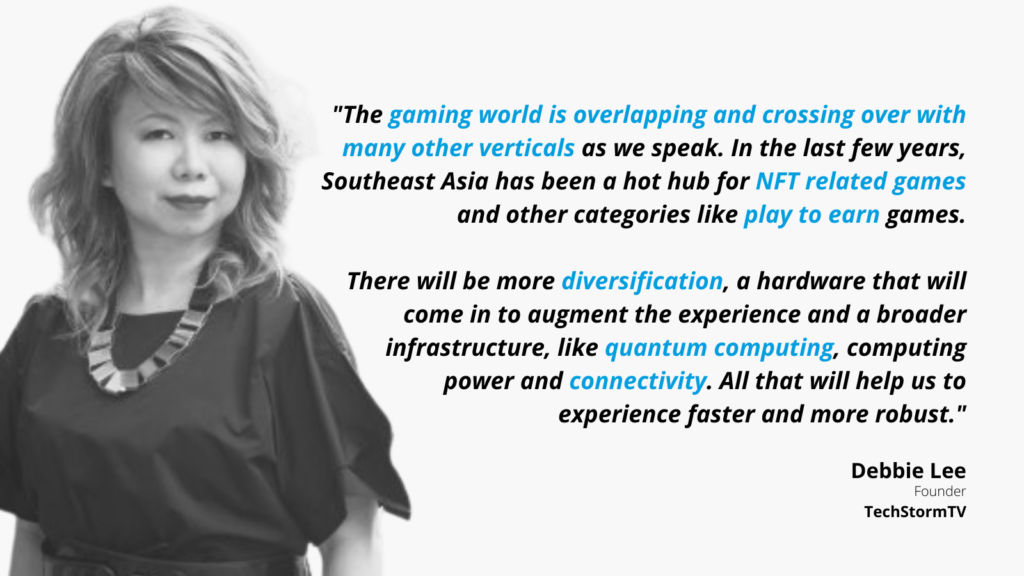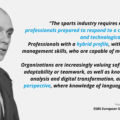31 Mar Have you met…Debbie Lee? – Female entrepreneurship, Esports immersion and Metaverse enigma
Chris Robb is the author of the book ‘Mass Participation Sports Events’; a highly sought after International Speaker; Advisor and CEO of Mass Participation Asia.
Chris’s life reads like the pages of a novel. His amazing journey has allowed him to impact the lives of millions of people by creating and delivering mass participation sports events across three continents.
While there have been countless highlights, including working on the Sydney 2000 Olympics and recently, meeting Sir Richard Branson at his home on Necker Island, Chris came from humble beginnings, growing up poor on a farm in Zimbabwe.
It has always been Chris’s belief that our greatest opportunity to grow and learn comes from times of extreme pressure.
Along the way, he discovered that events he initially perceived as “disasters”, were in fact gifts. These significant moments taught Chris the valuable lessons he needed to be successful in business, and what he could do to help other businesses achieve success.
Question: Debbie, please introduce yourself for our readers.
Answer: I’m the founder and CEO of the Esports video gaming media organization called TechStorm.
Starting my journey as an entrepreneur, I’m very much in the space of working with international or regional companies in the past, and my domain expertise is across three verticals. The first vertical is International Advertising, where I was with one of the world’s largest advertising agency group’s, TBWA, which is part of the Omnicom Group, and TWBA managed a lot of global brands.
Then I moved to technology, working with an American listed company, which was bought by Google. Post technology I moved into international media and the broadcast side of the business, where I was part of the leadership team members with a start-up TV channel called Asian Food Channel (now, Asian Food Network). This company has expanded to 11 territories before it was sold to the American Scripps network, and then I stepped out and headed for a UK company running the APAC office responsible for 11 to 13 countries under my geographical purview.
I’ve been part of technology, advertising, as well as international media, with a little bit of toe dipping into start-up exits, which has been incredibly exciting. I’ve also been traveling and done business in across 25 cities around the world. And I look forward to doing more.
Q: We know from the data in Europe that a lower percentage of women are represented in the sports tech industry. What about Asia? Can you share the situation? Did you find it challenging to be a CEO in a tech company in your region?
A: Asia is a very big region with a little bit of fragmentation across the different markets, and unfortunately, here we don’t have access to direct data points that really shows the 25-30 countries which are here in Pan Asia, for tech business.
What we do see in some of the data, is close to the numbers that North America has. I think the women representation across the tech sector, except probably China, is very much hovering between the 10% to probably a little bit under 25%.
What we do see and still consistently come back to is the gender pay gap between two professionals with similar capacity, job scope, etc.
A few of the observations that we see here in Asia, in terms of the share of dollars, female founder companies in the tech sector, having marginalized access to capital. That’s maybe 30% or less, depending on which country and when is the data is being taken.
There’s a lot more that we can do, collectively as a tech sector, because a female contribution to the tech ecosystem could potentially unlock easily, more than 100 trillion dollars, by most research from McKinsey. I think there could be more opportunity from which the economy could benefit.
I always have a little joke with friends that I’m typically what I call the double negative. First, I’m a female, which means I’m a little bit of a minority in the sector. Secondly, very interestingly, our brand attracts a huge skew of male fans, young men who are a huge enthusiast and passionate followers of our content. Our segment is about 60% – 70% male.
In my opinion, being a female is not necessarily a disadvantage in some ways, I think it is quite useful to look at building the business for our male fans, and our potential female fans that we want to attract.
Q: What advice would you give young women and girls to start their business in sports, Esports tech, tech in general?
A: There’s a lot of opportunities. One of the things that I really like is that technology doesn’t have a gender. If you are looking at just coding, R&D, a piece of invention or engineering, you can’t look at them and say, “I know that the inventor is a male or female”, because inventions on their own don’t have a gender. Being a female in the tech space is not necessarily a disadvantage, it just means that there’s more that needs to be done to be compensated in an equitable manner.
For all the young women out there, who want to be the industry, the sky’s the limit. There’s no stopping you. Whether you are a little girl or a little boy. Your ability to succeed is never about gender and should never be a consideration.
Q: Tell us a little bit more about TechStorm. How was it born? What are you doing? What is it standing for?
A: It was a journey when we first started but we iterated our model. It is built on a high waterfall Japanese mindset, the Kaizen methodology. What that means is that there are a few steps of ideation, testing, iteration, and then pivot and going back again to the ideation and testing model. It is a constant process of discovering new segments that align what we do. For us, our journey has taken us through two pivots and iterations. Our first iteration took us into Esports, and video gaming. We’re also moving into the next step, which will be taking us forward in the space of the Metaverse and web3.
We work on certain core values, the ownership of success, as well as taking failure and being humble enough to learn from them. We have a boldness to move forwards in uncharted waters. We are currently the largest in Southeast Asia, and the fastest growing since we’ve expanded to 11 territories, in the last two years. We’re coming to our third-year anniversary soon, and we have about 90 million very passionate community of Esports, video gaming and web3 enthusiasts.
I think we are in the early days of our journey, we still have quite a bit of forward journey ahead of us to do.
Q: And what are the trends in your area and Esports, and how do you foresee its future?
A: The gaming world is overlapping and crossing over with many other verticals as we speak. In the last few years, Southeast Asia has been a hot hub for NFT related games and of course, other categories like play to earn games.
I think there will be more diversification or different gameplay, there will be a hardware that will come in to augment the experience. There’ll be a broader infrastructure, like quantum computing, computing power, connectivity, all that will help us to experience faster and more robust. It is going to be very immersive.
I also think that the trends are probably quite limited. Because the space of Web3 is about how different verticals come together in a decentralized manner. Experiences can be built on top of each other. I believe convergence and intersection will be one of the biggest yet to be fully realized areas of trends that will come. The Metaverse is an example of how all of that comes together. You have the hardware, the software, the experiences built by designers, the augmentation of your participation in different activities. All of that is starting to intersect. It’s not one thing, but it’s multiple different things, like the sum of all parts.

Q: Can you explain in more detail how is the Metaverse linked to the Esports? What does it mean for Esports and why is everybody talking about it?
A: Metaverse is not new because it came from a generation where we use another word for Metaverse, it’s called Second Life. I think the community that is in the virtual space has always been there. For example, if you’re either playing a game with friends like Among Us, or you’re playing a more dynamic game play like League of Legends, you’re already in a closed network community. You can call it something else like a gaming community. But this has expanded horizontally laterally, you’re now able to build a virtualized three dimensional and experience it with community members that share the same interests. That’s the Metaverse as a loose concept.
No one can claim to be an expert on Metaverse because it’s so new. I believe in multiple Metaverses as opposed to one big Metaverse. That’s the way I see life in the future. There’ll be different Metaverses, experiences, communities, and virtual communities we can choose to join. One could be made just for you or for gamers and Esports. Esports, again, is very broad. Every game has its own followers and its own sort of community that is very much into it. We also could have different Metaverses that could be useful for work. Microsoft is obviously going down that path. We will see communities such as the ones that are a little bit professionally. We will see the virtualization of what we know today from a physical tangible environment, going virtual. In the world of Esports and gaming, you are already in that pseudo Metaverse on your own. So that itself is a very natural extension. And the reason why we’re seeing so much interest around how the Esports community, video gaming community will likely be the early adopters of the Metaverse concepts at some point.
Q: What are the opportunities Esports organizations as well as sports organizations have with the Metaverse? Can you give them any advice on how to tackle the Metaverse or how to start getting involved?
A: For sports organizations it will be a little bit different, but I think it can be interesting. How can certain communities of Esports or other sports enthusiasts also have a place in the Metaverse? The Metaverse is very much a virtual community of real people who take the shape and forms of avatars/personalities. In a sports world, could there be a virtualized sports competition in the Metaverse? There are different things that could come out of this interesting virtual world. Esports on the other hand is quite direct. I think most of us who play games, are quite used to entering the community or games that you are hooked on and create the avatar of your choice. So, the ability to relate to this is almost instantaneous, but in the sports world it’s hard to translate that because of very physical environment. Sports organizations can have a position in the virtual space, not 100% virtual, but some parts could. The same that we have virtual landscape, virtual property, virtual fashion, virtual currencies that we use to be able to transact experience to buy, to trade, etc. That’s how the physical world that we know today, could be virtualized. I am eager to see the intersections that will come out of the Metaverse.
Q: What are the next steps for TechStorm and you as professional? What are your plans for this year?
A: We just announced as a company structure that we’ve on boarded three new company advisors to our board advisors. We already had one, Mr. Reed Mangle from the USA. He was one of the former Hollywood veterans in this space in the USA, in one of the world’s largest entertainment output studios, International Joint Ventures.
The first is a gentleman we signed to our new board of advisors is from DBS digital exchange. He was a former head of the crypto exchange there. Our second is another gentleman from Gett (app), which is the equivalent of Uber. He was the former business leader in one of the divisions there. And the third is a gentleman from a corporate background, including SingTel, which is a telecom company. He’s a huge enthusiast in the web3 space.
This gives us a very nice advisory board to be able to shape our own journey into the space of the Web3, the Metaverse, Esports/video gaming that we already have. Moreover, we are slated for greater expansion; we’re now operating in 11 territories, mainly in Southeast Asia, where we are doing phenomenally well in the top countries of Indonesia and Philippines. We want to go deeper in terms of deeper engagement with the other markets in Southeast Asia. And of course, we want to expand geographically to other regions that we have not reached out to yet. We also have exciting new experiences that we hope to keep hidden for now as a surprise for our stakeholders and audience, and hopefully unveil it to them in the next six to nine months. Fingers crossed!






